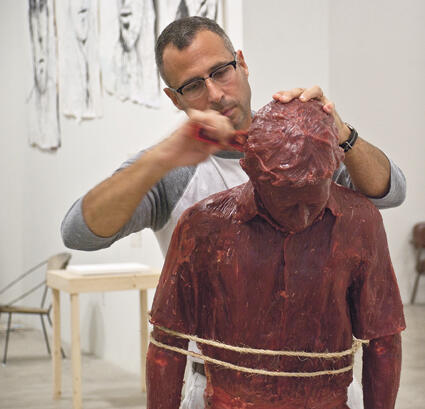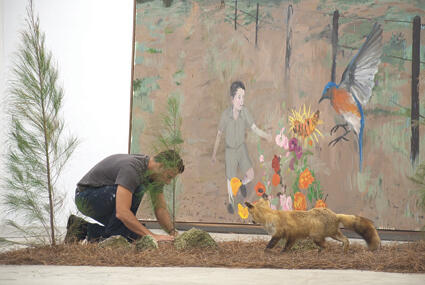Enrique Martínez Celaya: From Cliché to Archetype
Enrique Martínez Celaya’s summer 2013 exhibition at SITE Santa Fe follows a 2011-12 installation of Schneebett (2004) at the Miami Art Museum, and provides an opportunity to survey his career.

As general practice, Martínez Celaya creates images we wish to but cannot join. A boy stands alone in a meadow. Lightning flashes against a dark and stormy sky. Icebergs float in the sea. These scenes should speak to some part of us, but they remain too broad. We hope for something meaningful, but encounter the usual platitudes.
Dying was the theme of Martínez Celaya’s Schneebett, and everything since. That project was first shown in Berlin in 2004, and is a meditation on Beethoven’s final years. The installation includes a cast bronze bed covered with frost, a picture of a snowy forest made from paint, tar and feathers, a pile of branches, a poem by the artist written on a wall, entitled, “Poisonwood,” and a single empty chair; a symphony orchestra plays the protagonist’s later concertos. Rather than fusing art, poetry, and music, the redundant formats reveal the inadequacy of each to its subject. How could it be otherwise? No one can imagine the end of days. “I was humbled by the futility of Schneebett,” Martínez Celaya remarked in 2006.
Perhaps dissatisfaction with the status quo comes naturally to the artist. He is exceptionally articulate, and other writers have paid attention to his biography, especially his graduate studies in physics, readings in existential philosophy and literature, and family’s relocation from Cuba to the United States via Spain and Puerto Rico. Also referenced are the artists whose examples he has said were most valuable. Among others, earlier, there was Joseph Beuys, the Luftwaffe veteran who transformed a national vocabulary into a tool for personal and political repentance. Later also came Leon Golub, a Chicagoan who captured the plight of all people by painting the oppression of a few. “To be a prophet,” Martínez Celaya wrote in 2009, “an artist doesn’t need God but clarity of purpose, character, and attention.”
The best modern study of the quietism I see in Martéinez Celaya’s art is From Cliché to Archetype, a popular book written in 1970 by the Canadian pioneer of media studies, Marshall McLuhan, and the poet Wilfred Watson, who was active in Canada’s experimental theater community. As they explained, the cliché is a filter that shapes our perceptions, but once acknowledged becomes a probe to dissect commonplace assumptions. “Shakespeare smashes all the old clichés of love up to his time,” they observed, “and concludes with a curse on love.” Every destruction is to be embraced, since it frees our awareness from prevailing mindsets.
Once a cliché draws attention instead of slipping past without notice, it becomes “a catalyst to confront exile and foreignness,” which is a phrase Martínez Celaya used in characterizing Schneebett. This is a haunting work of art precisely because it probes our every attempted imagining, and lets us recognize that we come up empty.
Though Schneebett concluded Martínez Celaya’s Beethoven trilogy, the shock-and-awe ethics of the project remain. “ Schneebett is,” he noted, “the threshold.” One important lesson was that his creations interacted in unexpected ways. The inaccessible frozen bed proposed an imagined ecology that was logically and materially incompatible with the points of view suggested by the tar and feather painting. The indifference left no room for comfort.
Among other works, a series of four fifteen feet high by eleven feet wide paintings designed in 2010 for the Cathedral Church of St. John the Divine in New York City continued to create humility on an environmental scale. Entitled The Crossing and installed in pairs in the ambulatory alongside the nave, Martínez Celaya’s silent figures (one boy embraces a horse, another walks on crutches), empty rowboat, and path through a wintery wood challenge the soaring stained glass windows and the massive stone architecture.
Gentle, and with demanding perspectives, the brushed images lack the polished finish of gothic glass. There are drips of paint and smears of mud. The images stop short of the sides of the canvas, leaving the edges raw and exposed. The high horizons crush down on us like a weight, though the fluted stone columns of the cathedral soar. Here is where atheism mixes with the divine.
It is disjunction rather than continuity that creates an aesthetic experience where stock responses fail and free our desires. What was tried-and-true gains new life. McLuhan and Watson explained the reinvigoration of meaning in this way: “The archetype is a retrieved awareness or consciousness. It is consequently a retrieved cliché − an old cliché retrieved by a new cliché.”
Since Schneebett, Martínez Celeya has also made a number of delicate watercolors, including Girl and Sun (2005) and Boy and Skate (2005). Both are pocket versions of the installations, and Boy and Skate, for example, isolates the saltwater fish on the left half of the sheet of paper and shows the child embracing one on the right. Written below are the first three lines of “El niño yuntero” (“The Plowboy”) by Miguel Hernández (1910-1942), a Spanish poet who died in Francisco Franco’s prisons. In translation, the elegy begins with the sentence that most captured Martínez Celeya’s attention, “Flesh for the yoke, he was born more / humble than handsome, with his / neck pursued by the yoke for his neck.” The poem concludes with a Republican call to arms, which is not reproduced but relevant nonetheless: “Who will save this little boy / smaller than a grain of oats? / Where will the hammer come from, / that executioner of this chain? / Let it come from the heart / of these day-laboring men / who before becoming men are / and have been plowboys.” Combined, these images of skate, yoke, and hammer create associations that run in multiple directions, and overwhelm with their indeterminacy.
For Site Santa Fe, July 13, 2013 to October 13, 2013, Martínez Celeya continues his investigation of the power of clichés to become archetypes, thus probing our expectations and assumptions. Premised on the notion of “home,” the installation will seek to create an immersive experience from large paintings and sculptures, videos and smells. With such sensory overload, the artist will ask viewers to compare their present lives to the hopes and dreams of their childhoods, which perhaps allows both sadness and satisfaction simultaneously.
Biography:
Enrique Martínez Celaya is a Cuban American artist who was born in Havana in 1964. He emigrated with his family to Spain at the age of eight. He earned a BS in Physics from Cornell University and pursued a PhD in Quantum Electronic from the University of California, Berkeley, before deciding to devote himself fully to his artistic practices and earning an MFA from the University of California, Santa Barbara. Now based in Miami, his collected writings were published by the University of Nebraska Press in 2010, and his art is in the permanent collections of the Whitney Museum of American Art, The Los Angeles County Museum of Art, and the Metropolitan Museum of Art, among others.
-
 Works in progress for the SITE Santa Fe exhibition, “The Pearl”, Studio Enrique Martínez Celaya, Miami, Florida, 2013. Obras en curso para la exposición “The Pearl”, presentada en SITE Santa Fe, Estudio Enrique Martínez Celaya, Miami, Florida, 2013
Works in progress for the SITE Santa Fe exhibition, “The Pearl”, Studio Enrique Martínez Celaya, Miami, Florida, 2013. Obras en curso para la exposición “The Pearl”, presentada en SITE Santa Fe, Estudio Enrique Martínez Celaya, Miami, Florida, 2013 -
 Works in progress for the SITE Santa Fe exhibition, “The Pearl”, Studio Enrique Martínez Celaya, Miami, Florida, 2013. Obras en curso para la exposición “The Pearl”, presentada en SITE Santa Fe, Estudio Enrique Martínez Celaya, Miami, Florida, 2013
Works in progress for the SITE Santa Fe exhibition, “The Pearl”, Studio Enrique Martínez Celaya, Miami, Florida, 2013. Obras en curso para la exposición “The Pearl”, presentada en SITE Santa Fe, Estudio Enrique Martínez Celaya, Miami, Florida, 2013 -
 Works in progress for the SITE Santa Fe exhibition, “The Pearl”, Studio Enrique Martínez Celaya, Miami, Florida, 2013. Obras en curso para la exposición “The Pearl”, presentada en SITE Santa Fe, Estudio Enrique Martínez Celaya, Miami, Florida, 2013
Works in progress for the SITE Santa Fe exhibition, “The Pearl”, Studio Enrique Martínez Celaya, Miami, Florida, 2013. Obras en curso para la exposición “The Pearl”, presentada en SITE Santa Fe, Estudio Enrique Martínez Celaya, Miami, Florida, 2013




